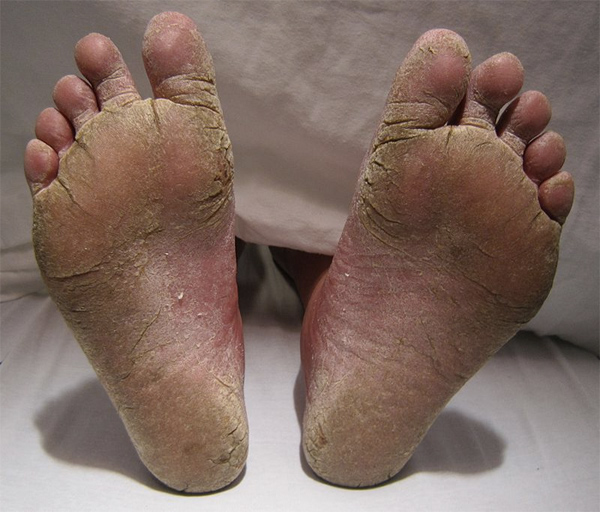“Foot” and “fungus” are two words you never want to see paired together. Unfortunately, that revolting combination is precisely what happens under the right conditions. In many ways, you are more likely to come across the offending fungi while you are traveling. More time in shared spaces, hotel rooms, and possibly swimming pools and locker rooms, will greatly increase your chances of contracting athlete’s foot.
What exactly is athlete’s foot
Ok, so it’s a fungus. But let’s be more specific. Athlete’s foot is really a skin infection caused by a fungus. Redness, itching, scaling, and blistering can all be signs and symptoms. Your feet don’t necessarily need to look like the picture below, either:
In fact, many cases of athlete’s foot simply affect the area in between the toes.
There are several different species of fungi that can cause athlete’s foot. Guess what? They all thrive in places like locker rooms, gymnasiums, swimming pools and hotel rooms that are not properly (or frequently) cleaned. The fungi may be present elsewhere, but your greatest chances of coming in contact with them is in these types of environments.
How to avoid athlete’s foot when traveling
Athlete’s foot can easily be avoided if you take the following precautions:
- Choose your accommodation wisely. One of the internet’s greatest assets is websites that provide first hand testimony. If you read 20 reviews on TripAdvisor, and they all say that a hotel has dirty rooms and filthy showers, don’t stay there. Take advantage of the misfortune of others. If someone stayed in a lousy place, learn from their mistake, don’t repeat it.
- Be smart about your footwear. If you are doing lots of walking and/or physical activity, change up your footwear when you are back at the hotel or relaxing somewhere. Don’t wear constrictive, closed-toe shoes for days on end and not expect the moisture and warmth to foster the perfect environment for athlete’s foot. Take a break and put on some sandals once in a while. Your feet will be much happier for it.
- Wash and change socks frequently. Even the most advanced moisture wicking socks were not meant to be worn for days on end. Wash your socks after daily use. If you know that you won’t have access to laundry often on your trip, pack a lot of socks – don’t worry, they don’t take up that much space.
- Wear sandals in your hotel room and bathroom. Whether or not the room appears to be spotless, it is still a good idea to wear sandals around the room, and especially in the bathroom. At the end of the day, this may be the most important piece of advice on the list.
Ok, that’s all well and good, but what if I end up getting athlete’s foot anyway?
How to treat athlete’s foot
There are all sorts of remedies for treating athlete’s foot, but we are going to stick with what’s been proven to be most effective.
– First and foremost, you need to practice exceptional hygiene if you want to find yourself on the road to treating athlete’s foot. Wash and dry your feet several times a day.
– Use an antifungal topical ointment that will help to treat the infection directly. There are a variety of options that are available over the counter. Feel free to consult your doctor or pharmacist depending on the severity of the infection.
– Get rid of any shoes that you were wearing when you contracted athlete’s foot. You may be able to bleach them, but it’s better to just toss them and move on with new shoes that you know are not contaminated. Equally important, make sure all socks are thoroughly washed in a bleach solution along with soap and hot water.
Treatment often takes a couple of weeks, because your skin will need to enter into a new cycle and shed the outer layers. If the condition does not improve or if it gets worse, do not hesitate to consult your doctor.
How about you? Any athlete’s foot war stories? We would love to hear them in the comments below.













{ 0 comments… add one }